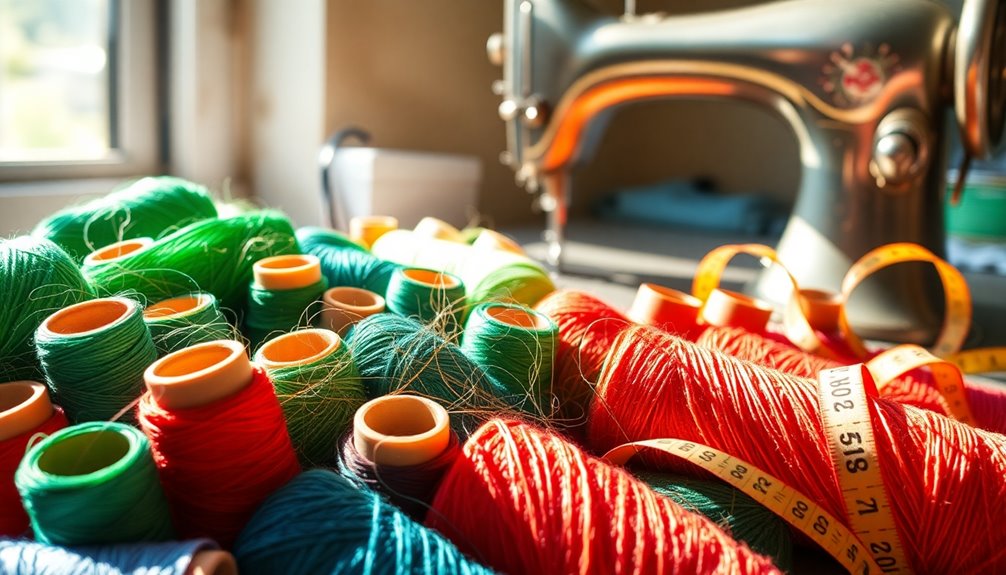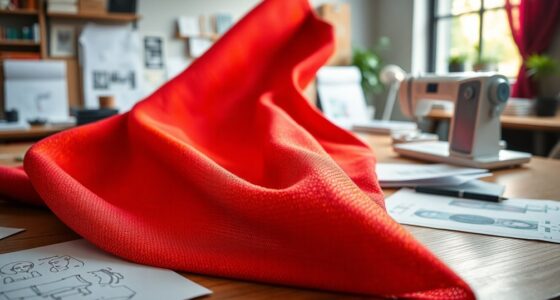To achieve sewing success, start by choosing the right thread type for your fabric. Natural fibers work best for breathable materials, while polyester threads offer strength for durability. Keep your threads organized in visible containers and label them for easy access. Confirm proper threading techniques and adjust tension settings based on fabric weight to avoid issues. If you encounter thread bunching or tension problems, don't worry—there are simple fixes. Discover more tips and tricks to perfect your sewing skills!
Key Takeaways
- Choose the right thread type and weight to match your fabric for a polished finish and prevent issues while sewing.
- Organize your threads using clear containers and label them by type and weight for easy access and selection.
- Regularly check and maintain your sewing machine, including cleaning and changing needles, to ensure optimal performance and stitch quality.
- Adjust thread tension settings based on fabric weight, testing on scrap fabric to achieve the best stitch results.
- Troubleshoot common thread issues by ensuring proper threading, checking tensions, and clearing any tangles or bunching before starting a project.
Understanding Thread Types and Their Uses
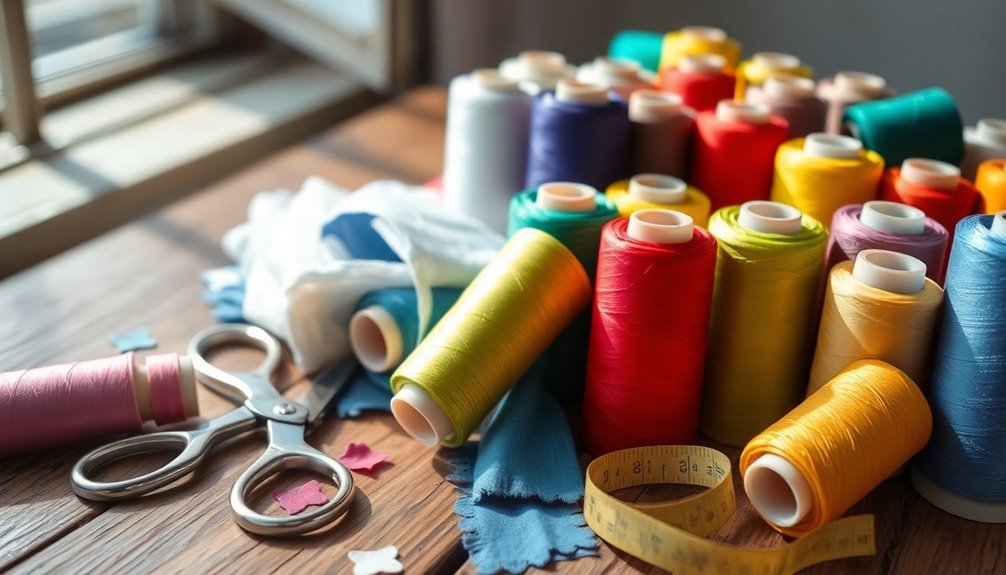
When you immerse yourself in sewing, understanding the different types of thread can make a significant difference in your projects. Familiarizing yourself with thread types is essential for achieving the best results.
Natural fibers like cotton and silk are breathable and work well with natural fabrics, while synthetic fibers such as polyester and nylon offer durability and versatility for various projects.
When choosing the right sewing threads, consider the weight: lightweight threads (60wt) are perfect for delicate fabrics, while medium-weight (50wt) suits all-purpose sewing. For heavier materials, heavyweight threads (30wt) provide added strength.
Don't forget about specialty threads, like elastic for shirring or jeans topstitching thread for denim, which enhance functionality and elevate your work to a professional level.
Choosing the Right Thread for Your Fabric
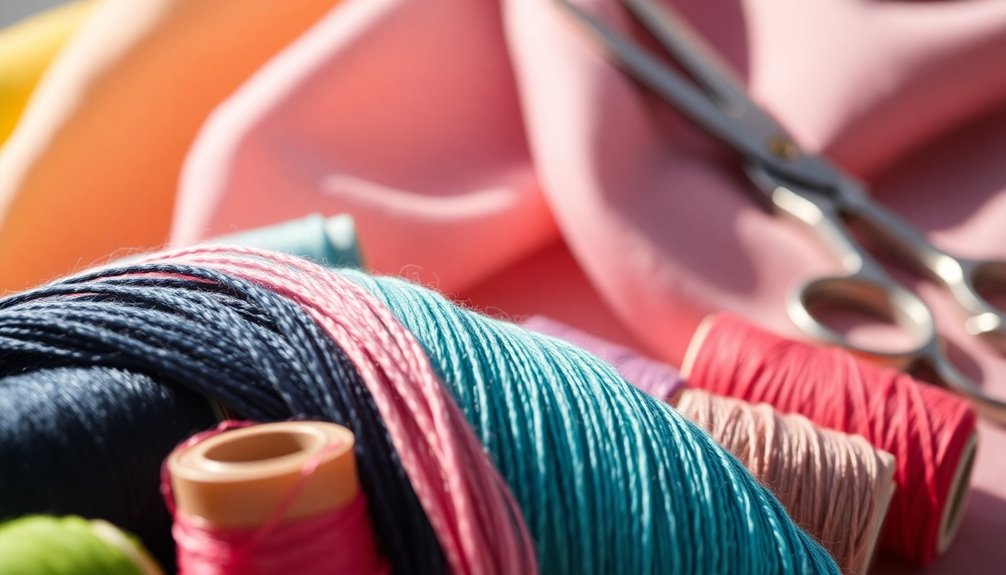
Selecting the right thread for your fabric is key to achieving a polished finish in your sewing projects. Start by matching the thread weight to your fabric weight; lightweight threads work best for delicate fabrics, while heavyweight threads excel with materials like denim.
If you're working with stretchy fabrics, opt for stretchable threads, like nylon, to guarantee seams flex without breaking. Consider your thread content, too—cotton thread is breathable but weaker, whereas polyester thread provides strength and durability.
Always consult fabric recommendations for specific thread types, as the right thread choice can enhance your project's quality. Keep a variety of thread types on hand, like all-purpose and heavy-duty, to tackle diverse fabric needs effectively.
Best Practices for Thread Management
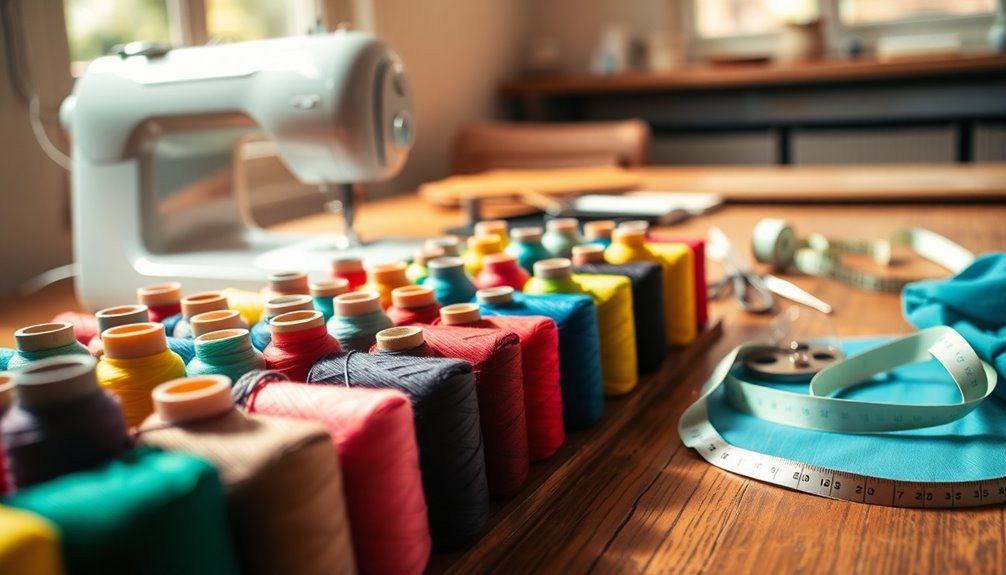
When it comes to managing your thread, organization is key to preventing tangles and breaks.
Keep your threads stored properly to maintain their quality and guarantee easy access during your projects.
Organizing Thread Storage
A well-organized thread storage system can make all the difference in your sewing projects. By keeping your threads neat and accessible, you save time and frustration while working with your sewing machines.
Here are three best practices to elevate your thread organizing game:
- Use clear storage containers or thread racks to keep spools visible and untangled.
- Label each container or shelf with thread types and weights for easy selection.
- Store threads away from direct sunlight to prevent fading and degradation.
Don't forget to regularly check for expired or damaged threads, as older threads can break easily and jeopardize your hard work.
With these tips, you'll enjoy a more efficient and enjoyable sewing experience!
Preventing Tangles and Breaks
To prevent frustrating tangles and breaks while sewing, it's crucial to pay attention to your thread management practices.
Always raise the presser foot when you thread the machine; this helps seat the upper thread properly in the tension discs and prevents issues.
Regularly check and clean the hook area and stitch plate to remove lint that can cause binding and thread breaks.
Use a foam disc or similar holder to maintain proper tension and stop the upper thread from catching.
Adjust your thread tension according to the fabric type and thickness for consistency.
If you encounter a blockage, don't yank the fabric. Instead, cut the threads above the stitch plate and re-thread the machine to resolve the issue effectively.
Proper Threading Techniques to Avoid Issues

Proper threading techniques are essential for smooth sewing, as even minor mistakes can lead to frustrating issues like thread bunching. To avoid these problems, follow these steps:
- Always raise the presser foot when threading the upper thread. This guarantees it passes correctly through the tension discs.
- Position the upper thread carefully in the pretensioner and thread take-up lever to maintain consistent tension.
- Follow the marked thread path on your sewing machine closely. Misthreading can cause unnecessary interruptions and headaches.
Regularly check that the upper thread isn't catching on any parts of the machine while sewing.
For additional help, refer to instructional videos or your sewing machine manual to master proper threading techniques tailored to your model.
Adjusting Tension Settings for Optimal Stitching
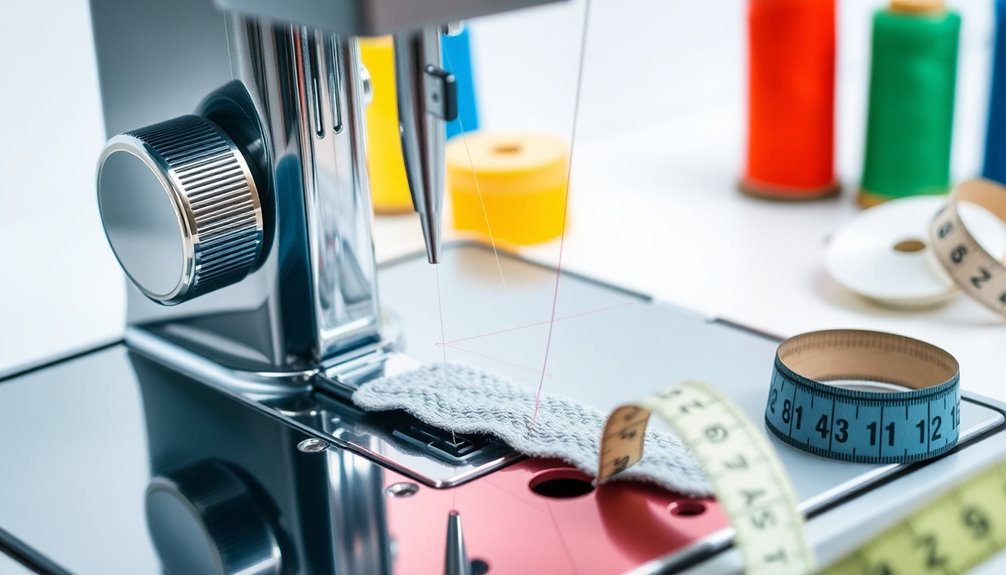
Getting your thread tension just right is key to achieving beautiful, balanced stitches.
You'll need to adjust your settings based on the fabric type and thread weight you're using.
Let's explore how to find that sweet spot for ideal stitching every time.
Importance of Thread Tension
While achieving balanced stitches may seem straightforward, the importance of thread tension can't be overstated. Proper thread tension is essential; too tight can cause puckering, while too loose leads to skipped stitches or bunching.
By utilizing adjustable tension settings on your sewing machine, you can tailor the tension for different fabric weights.
Here are three key points to remember:
- Regularly test tension on scrap fabric to find ideal settings.
- Adjust upper thread tension in conjunction with bobbin tension for best results.
- Consult your sewing machine's manual for specific tension guidelines.
Getting your thread tension right guarantees your projects look professional and polished, making your sewing experience more enjoyable!
Adjusting for Fabric Type
When you're sewing, adjusting tension settings based on fabric type is essential for achieving the best stitch quality.
Start by adjusting the upper thread tension; lighter fabrics require lower tension, while heavier ones need higher settings. If you're working with thin fabrics, consider turning off securing stitches to avoid bunching.
For stretchy materials, use a stretchable sewing thread and set the tension to accommodate the fabric's elasticity, preventing puckering. Familiarize yourself with your sewing machine's setup menu to make precise adjustments.
Always test stitch settings on a scrap piece of the same fabric before starting your project to verify you've set the tension correctly for ideal results. This practice will help you achieve smooth, professional-looking seams every time.
Common Causes of Thread Bunching
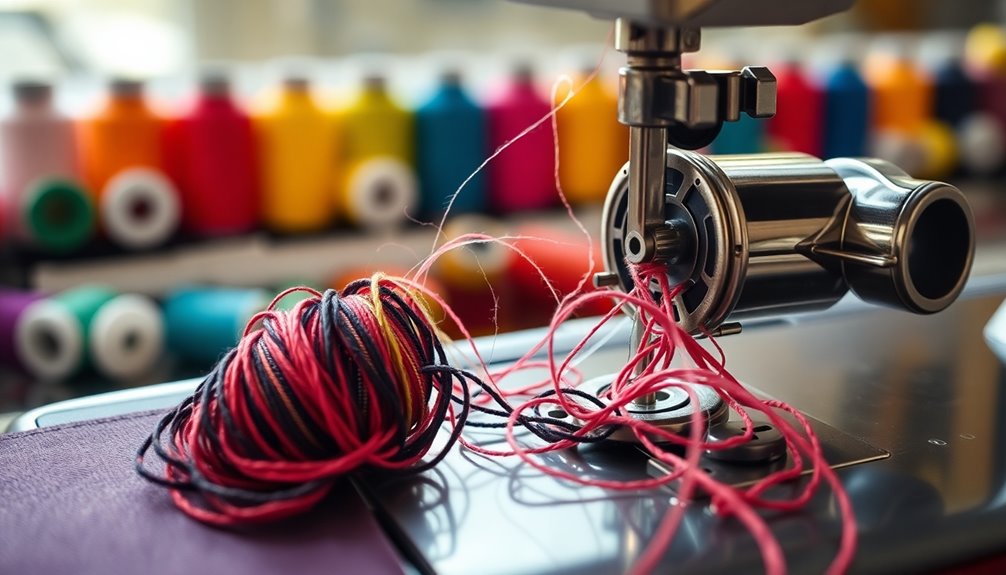
Thread bunching can be frustrating, especially since it's often misattributed to lower thread issues.
In reality, improper upper thread tension, the wrong needle, and threading mistakes are the main culprits.
Here are three common causes to watch out for:
- Improper upper thread tension – If it's too loose or too tight, it can lead to bunching on the underside.
- Using the wrong needle – A needle that's too thick or too thin can exacerbate thread bunching issues.
- Threading mistakes – Not properly threading your machine can create tangles, so always raise the presser foot to guarantee the upper thread sits correctly in the tension discs.
How to Resolve Thread Bunching Problems

To tackle thread bunching problems effectively, start by checking your upper thread tension. Incorrect tension is often the main culprit behind bunching on the underside of your fabric.
Make sure you've threaded the upper thread correctly through all components, including the pretensioner, tension discs, and the thread take-up lever. Remember to raise the presser foot while threading; this helps the thread seat properly in the tension discs.
If you're working with thick fabrics, lower the presser foot before sewing to keep the fabric smooth and avoid catching.
Regularly inspect the upper thread for any catches or entanglements, and adjust the tension settings as needed. These common sewing tips will help you achieve a smoother sewing experience.
Tips for Maintaining Your Sewing Machine
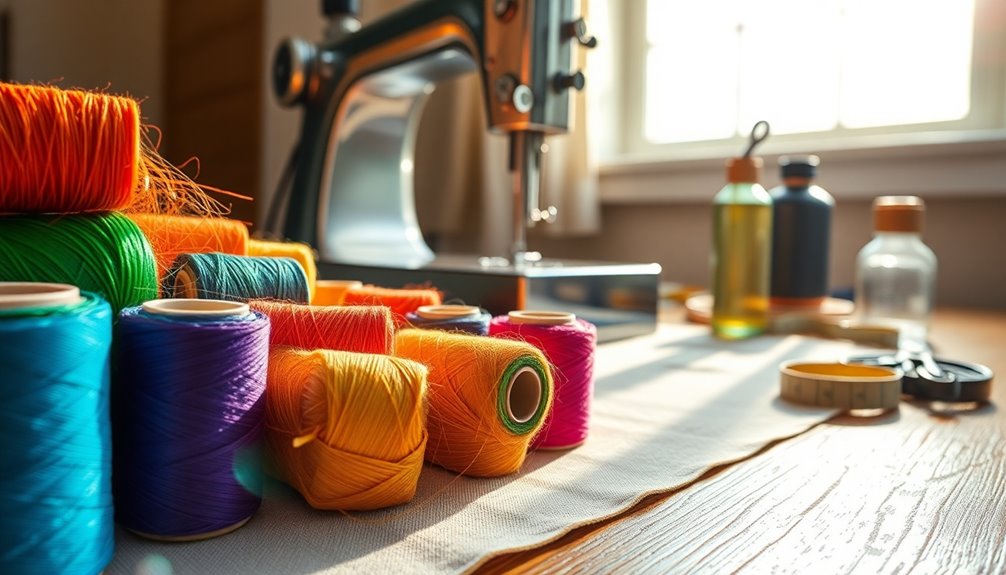
Maintaining your sewing machine is essential for achieving consistently high-quality results.
A well-cared-for machine not only enhances your sewing experience but also prolongs its life.
Here are three key tips to keep in mind:
- Regularly clean your sewing machine by removing lint and dust from the bobbin area and feed dogs to prevent thread bunching.
- Change the needle every 6 to 8 hours of sewing to avoid fabric snags and guarantee clean stitches.
- Check thread tension settings frequently, as incorrect tension can lead to uneven stitches and thread breakage.
Essential Tools for Managing Threads
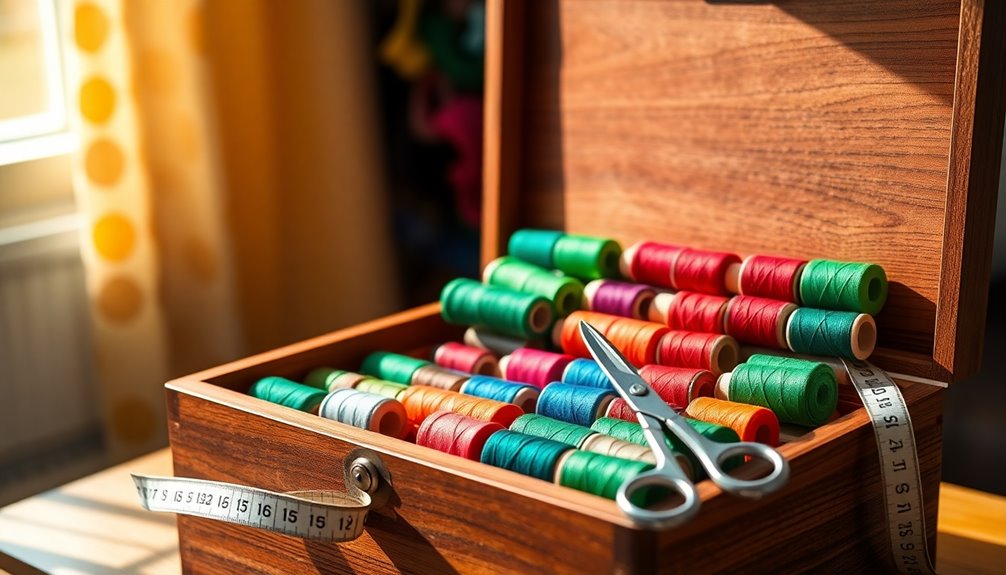
To keep your sewing space organized, you need the right tools for managing threads.
Using storage solutions like thread organizers and bobbin holders will save you time and hassle.
Plus, having essential tools like thread cutters and needle threaders on hand can make your sewing projects run smoothly.
Thread Storage Solutions
Effective thread storage solutions can make all the difference in your sewing projects. When you have organized threads, finding the right one becomes a breeze. Here are three effective storage ideas to evaluate:
- Clear Plastic Organizers: Use adjustable compartments to sort threads by color or type, ensuring quick access.
- Wall-Mounted Thread Racks: Save space while showcasing your collection, allowing easy visibility of all available colors.
- Labeled Storage Bins: Separate specialty threads like metallic or elastic for effortless locating.
Don't forget to implement a thread inventory system, either digitally or on paper. This helps you track supplies and usage, preventing those frustrating moments of running out of essential colors mid-project.
With these solutions, your sewing space will be efficient and inspiring!
Thread Organization Techniques
Organizing your threads can transform your sewing experience, making it smoother and more enjoyable. Here are some effective thread organization techniques:
| Tip | Description |
|---|---|
| Sort by Color | Use clear plastic bins or drawer organizers. |
| Utilize Spool Holders | Invest in stands to prevent tangling and guarantee smooth feeding. |
| Label Containers | Clearly mark thread type and weight for easy access. |
Keeping a thread inventory list helps you track colors and quantities, making it easier to find the right thread for your projects. Consider using a dedicated sewing box or caddy to store your essential tools. These sewing tips will save you time and enhance your creativity!
Essential Thread Tools
Having the right tools can make a significant difference in managing your threads and enhancing your sewing experience. Here are three essential tools you shouldn't sew without:
- Thread Organizer: This handy tool helps you separate and store different types and colors of thread, reducing tangling and making it easy to find what you need.
- Needle Threader: Perfect for simplifying the threading process, especially if you have limited dexterity or vision challenges.
- Bobbin Cases: Keeping these organized and labeled prevents confusion, ensuring you grab the right bobbin for each project.
Investing in these essential thread tools not only boosts your efficiency but also elevates your overall sewing enjoyment.
Say goodbye to the chaos and hello to a smoother sewing journey!
Troubleshooting Common Thread-Related Issues
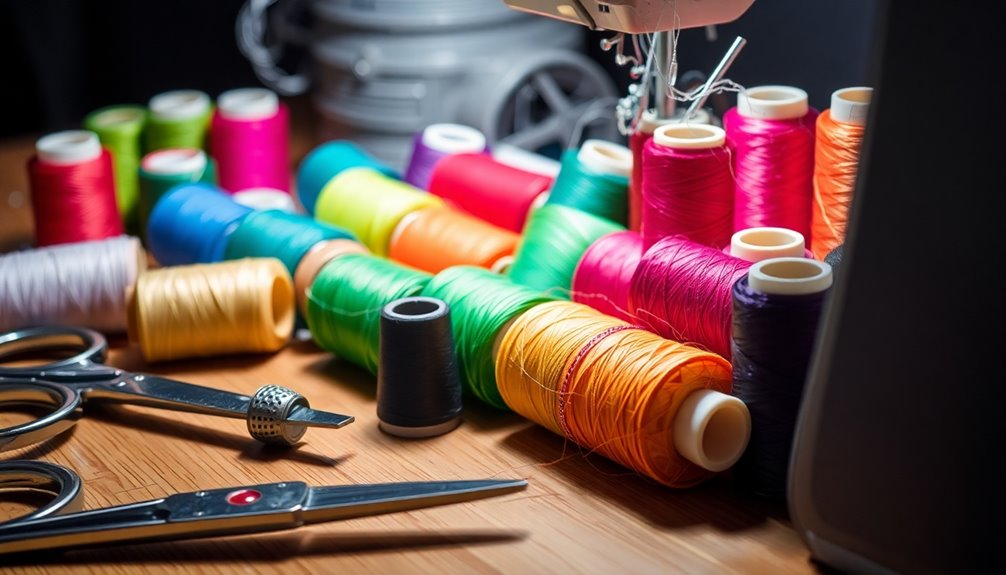
When you encounter thread-related issues while sewing, it can be frustrating, but addressing them is often simpler than you might think.
One common problem is thread bunching, which typically appears on the underside of your fabric. This usually stems from improper upper thread tension. To prevent this, always raise the presser foot when threading the upper thread and guarantee it's seated correctly in the tension discs and take-up lever.
If you experience blockage or catching, don't pull the fabric; instead, remove the presser foot and needle to clear tangled threads. Adjusting your machine settings, like turning off securing stitches for thin fabrics, can also help.
Regularly check that your presser foot is lowered, especially with thicker materials.
Frequently Asked Questions
What Does Tex 27 Mean in Thread?
Tex 27 refers to a specific thread weight, indicating it has a linear density of 27 grams per 1,000 meters.
When you choose Tex 27, you're selecting a medium-weight thread that's ideal for general sewing tasks and medium-weight fabrics.
This classification helps you match the thread with your fabric, ensuring strong and attractive seams.
If you're using a sewing machine, it'll likely handle Tex 27 well, providing quality stitching for your projects.
What Is the Most Important Rule of Sewing?
The most important rule of sewing is to always match the thread weight to the fabric weight. This guarantees you get even stitching and prevents puckering, which can ruin your project.
Take the time to check that your thread and fabric complement each other. When you follow this guideline, you'll notice a significant difference in the quality of your work, making your sewing experience much more enjoyable and successful.
What Are the Five Desirable Qualities of Sewing Thread?
When you're choosing sewing thread, think of it as selecting the backbone of your project. You want thread that's strong, smooth, and reliable.
Look for high tensile strength to guarantee durability, and pick a smooth thread to avoid those pesky snags.
Colorfastness is key for lasting beauty, while flexibility allows for seamless movement with your fabric.
Finally, minimal shrinkage will keep your creations looking sharp over time, preserving their shape and fit.
How to Prep Thread for Sewing?
To prep thread for sewing, start by selecting the right weight and type for your fabric.
Raise the presser foot while threading the upper thread to guarantee it seats correctly in the tension discs. Make sure the thread runs through all components, following your machine's marked path.
Consider placing a felt sponge under the spool to prevent unraveling.
Finally, inspect the thread for tangles or frays to maintain consistent stitching.
Conclusion
In summary, mastering thread basics is the key to revealing a world of sewing possibilities. With the right techniques and knowledge, you'll transform your projects from ordinary to extraordinary—like a magician pulling a rabbit out of a hat! Remember to choose the right thread, manage it wisely, and keep your machine in tip-top shape. Embrace these tips, and soon you'll be stitching like a pro, tackling any sewing challenge that comes your way!
